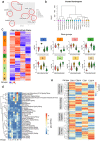Distinct Inflammatory Macrophage Populations Sequentially Infiltrate Bone-to-Tendon Interface Tissue After Anterior Cruciate Ligament (ACL) Reconstruction Surgery in Mice
- PMID: 35866148
- PMCID: PMC9289991
- DOI: 10.1002/jbm4.10635
Distinct Inflammatory Macrophage Populations Sequentially Infiltrate Bone-to-Tendon Interface Tissue After Anterior Cruciate Ligament (ACL) Reconstruction Surgery in Mice
Abstract
Macrophages are important for repair of injured tissues, but their role in healing after surgical repair of musculoskeletal tissues is not well understood. We used single-cell RNA sequencing (RNA-seq), flow cytometry, and transcriptomics to characterize functional phenotypes of macrophages in a mouse anterior cruciate ligament reconstruction (ACLR) model that involves bone injury followed by a healing phase of bone and fibrovascular interface tissue formation that results in bone-to-tendon attachment. We identified a novel "surgery-induced" highly inflammatory CD9+ IL1+ macrophage population that expresses neutrophil-related genes, peaks 1 day after surgery, and slowly resolves while transitioning to a more homeostatic phenotype. In contrast, CX3CR1+ CCR2+ macrophages accumulated more slowly and unexpectedly expressed an interferon signature, which can suppress bone formation. Deletion of Ccr2 resulted in an increased amount of bone in the surgical bone tunnel at the tendon interface, suggestive of improved healing. The "surgery-induced macrophages" identify a new cell type in the early phase of inflammation related to bone injury, which in other tissues is dominated by blood-derived neutrophils. The complex patterns of macrophage and inflammatory pathway activation after ACLR set the stage for developing therapeutic strategies to target specific cell populations and inflammatory pathways to improve surgical outcomes. © 2022 The Authors. JBMR Plus published by Wiley Periodicals LLC on behalf of American Society for Bone and Mineral Research.
Keywords: ANIMAL MODELS; INJURY/FRACTURE HEALING; ORTHOPAEDICS; OSTEOIMMUNOLOGY; SYSTEMS BIOLOGY ‐ BONE INTERACTORS.
© 2022 The Authors. JBMR Plus published by Wiley Periodicals LLC on behalf of American Society for Bone and Mineral Research.
Conflict of interest statement
The authors declare that there are no conflicts of interest regarding the publication of this paper.
Figures






References
Grants and funding
LinkOut - more resources
Full Text Sources
Molecular Biology Databases
